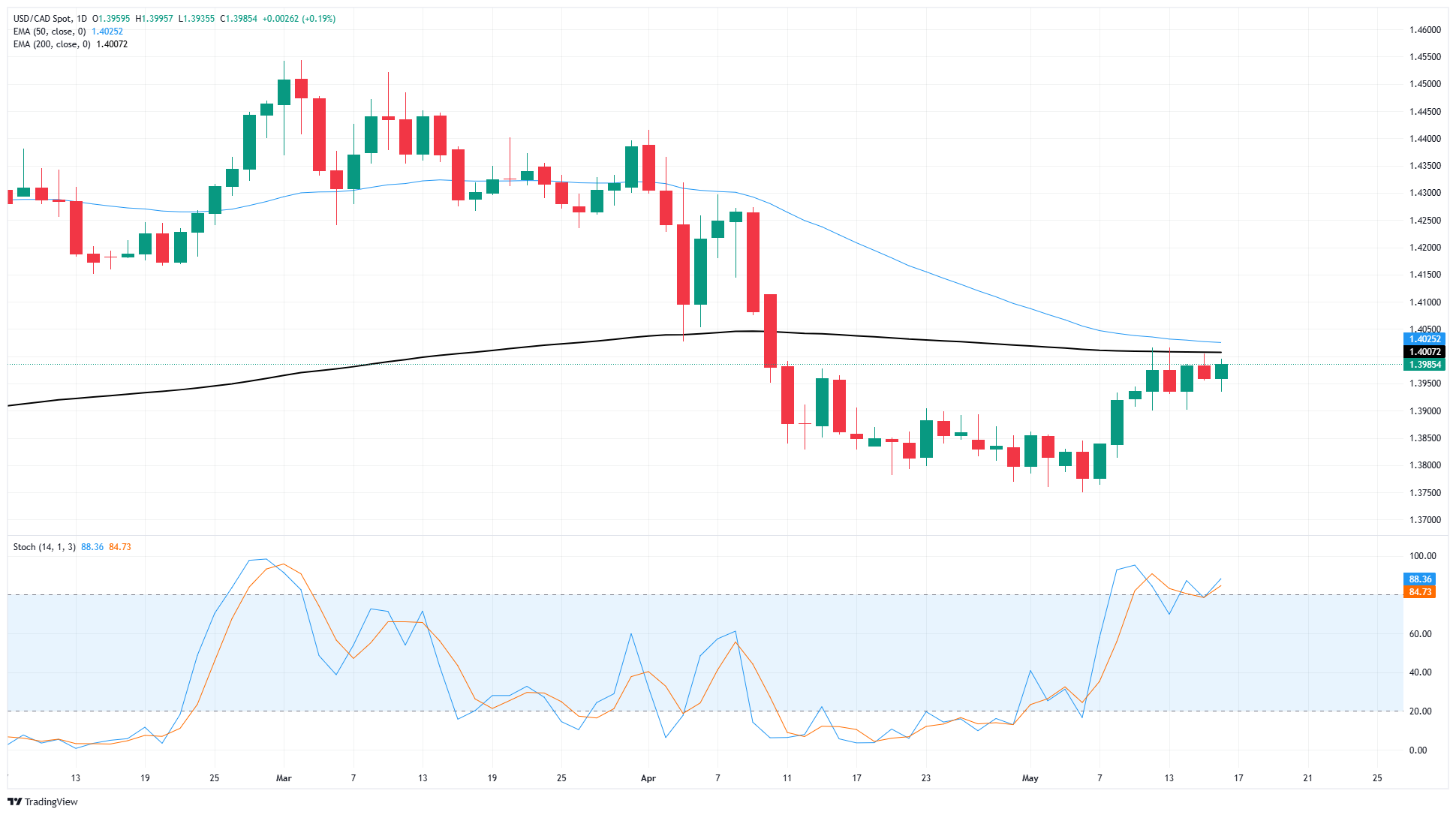Canadian Dollar backslides once again, remains rangebound
- The Canadian Dollar stuck to familiar territory on Friday.
- The Loonie is trapped in a hard congestion zone against the Greenback.
- CAD traders forced to wait through a long weekend before key Canadian inflation data.
The Canadian Dollar (CAD) continued its back-and-forth pattern against the US Dollar (USD) on Friday. The Loonie pared away the previous day’s gains and kept USD/CAD pinned near the 1.4000 handle. Global market attention remains firmly transfixed on the Trump administration’s constantly changing trade policy strategy, keeping investor risk appetite trapped in an on-again, off-again cycle.
The latest round of Canadian inflation data is rounding the corner with the Canadian Consumer Price Index (CPI) slated for next Tuesday. However, Loonie traders will first have to survive a long weekend with Canadian markets shuttered for the upcoming Victoria Day holiday on Monday.
Daily digest market movers: Canadian Dollar remains stuck in a rut
- The Canadian Dollar continues to churn chart paper near the 1.4000 level against the Greenback. The Loonie shed one-fifth of one percent against the USD on Friday, keeping USD/CAD firmly embedded in near-term consolidation.
- The University of Michigan (UoM) Consumer Sentiment Index showed another drop in consumer economic expectations, sinking to the second-lowest print on record for the key sentiment indicator.
- US consumer inflation expectations have also risen to multi-year highs as price impacts from tariffs loom just over the horizon.
- Wall Street has broadly brushed off souring consumer sentiment; however, consumers and investors share tariff concerns.
- Canadian CPI inflation figures are due next week; headline CPI inflation for the year ended in April is expected to droop sharply to 1.6% YoY, and fall well below the Bank of Canada’s (BoC) 2% target band.
Canadian Dollar price forecast
Middling is the name of the game for the Loonie in recent chart action. USD/CAD remains firmly entrenched in a consolidation phase, with bids stuck just south of the 1.4000 handle. Price action has become hung up on the 200-day Exponential Moving Average (EMA), and it will take a significant push to generate a break and retest of key technical levels before a trend in either direction can be established.
USD/CAD daily chart

Canadian Dollar FAQs
The key factors driving the Canadian Dollar (CAD) are the level of interest rates set by the Bank of Canada (BoC), the price of Oil, Canada’s largest export, the health of its economy, inflation and the Trade Balance, which is the difference between the value of Canada’s exports versus its imports. Other factors include market sentiment – whether investors are taking on more risky assets (risk-on) or seeking safe-havens (risk-off) – with risk-on being CAD-positive. As its largest trading partner, the health of the US economy is also a key factor influencing the Canadian Dollar.
The Bank of Canada (BoC) has a significant influence on the Canadian Dollar by setting the level of interest rates that banks can lend to one another. This influences the level of interest rates for everyone. The main goal of the BoC is to maintain inflation at 1-3% by adjusting interest rates up or down. Relatively higher interest rates tend to be positive for the CAD. The Bank of Canada can also use quantitative easing and tightening to influence credit conditions, with the former CAD-negative and the latter CAD-positive.
The price of Oil is a key factor impacting the value of the Canadian Dollar. Petroleum is Canada’s biggest export, so Oil price tends to have an immediate impact on the CAD value. Generally, if Oil price rises CAD also goes up, as aggregate demand for the currency increases. The opposite is the case if the price of Oil falls. Higher Oil prices also tend to result in a greater likelihood of a positive Trade Balance, which is also supportive of the CAD.
While inflation had always traditionally been thought of as a negative factor for a currency since it lowers the value of money, the opposite has actually been the case in modern times with the relaxation of cross-border capital controls. Higher inflation tends to lead central banks to put up interest rates which attracts more capital inflows from global investors seeking a lucrative place to keep their money. This increases demand for the local currency, which in Canada’s case is the Canadian Dollar.
Macroeconomic data releases gauge the health of the economy and can have an impact on the Canadian Dollar. Indicators such as GDP, Manufacturing and Services PMIs, employment, and consumer sentiment surveys can all influence the direction of the CAD. A strong economy is good for the Canadian Dollar. Not only does it attract more foreign investment but it may encourage the Bank of Canada to put up interest rates, leading to a stronger currency. If economic data is weak, however, the CAD is likely to fall.
